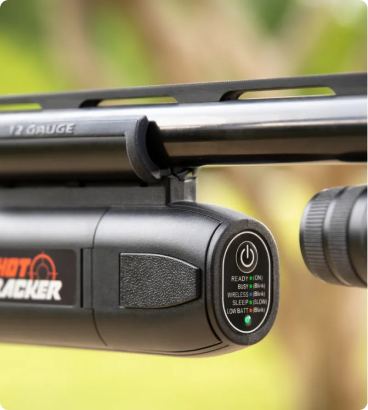Data-Driven Confidence – Building Shooter Confidence with ShotTracker Feedback
Confidence is a shooter’s secret weapon. When a shotgun shooter steps up to the line believing in their technique and expecting success, the results often follow. Building that confidence, however, can be challenging, especially after missed targets or a slump in performance. This is where ShotTracker’s real-time feedback and data analytics shine – by providing clear, objective insights, they help shooters replace doubt with knowledge. Over time, knowledge turns into improved skills, and improved skills breed confidence. Let’s explore how leveraging data can enhance a shooter’s mental game.
The Confidence Curve in Shooting
Every shooter experiences highs and lows. A new shooter might start uncertain, then gain confidence as they hit more targets. Conversely, even experienced competitors can lose confidence after an unexpected bad day. The goal is to maintain an upward confidence curve – steadily growing self-assurance rooted in real capability. ShotTracker assists on this journey by acting as a supportive coach that’s always present. It doesn’t replace human coaching, but it reinforces it, reminding the shooter of what they’re doing right and pinpointing what to fix when things go wrong. This consistent, transparent feedback removes a lot of the “mystery” after a miss. Instead of a shooter walking off the station thinking, “I don’t know what I’m doing wrong, I just can’t hit today,” they can look at the data and say, “Oh, I’m consistently behind the target. I can fix that.” Knowing the problem is the first step to regaining confidence.
Immediate Feedback Prevents Negative Habits
One of the dangerous things that can erode confidence is when a shooter starts guessing and second-guessing after misses. Without feedback, a shooter might begin to change their technique haphazardly – moving their feet, changing their hold point, altering their swing – in an effort to solve the problem. This can lead to negative habits or abandoning fundamentals that were actually sound. ShotTracker’s real-time feedback stops that cycle. For example, if an athlete misses a clay, they can glance at the ShotTracker analysis right away. It might show that their muzzle dipped slightly as they pulled the trigger (perhaps due to a flinch). That immediate insight tells the shooter, “Your fundamentals were fine up to the last moment – just work on a smooth trigger pull.” They won’t start doubting their stance or eye position or other aspects, so those good habits remain intact. By correcting course quickly and only in the area needed, shooters maintain trust in the bulk of their technique, which keeps their overall confidence level higher.
Tracking Progress to See Improvement
Confidence grows when you can see that you’re better today than you were yesterday. ShotTracker’s data logging makes progress (or problem areas) visible over time. Let’s say a shooter is working on increasing their hit percentage on left-moving targets in sporting clays. A month ago, they hit 50% of them. With practice and using ShotTracker to fine-tune their lead and timing, they’re now hitting 70%. If they only judged by memory or gut feeling, they might not fully appreciate that improvement. But with data, it’s right there in black and white (or perhaps in chart form on the app!). Celebrating those concrete improvements is a big confidence booster. The shooter thinks, “If I improved that much in a month, I can improve even more.” Similarly, data can highlight consistency – maybe your last 5 practice sessions all hover around the same score, indicating you’ve reached a new plateau of skill. That consistency is confidence-building; you’re no longer wildly fluctuating.
It’s also worth noting the effect of seeing improvement in specific metrics. A shooter could discover that their average reaction time to targets has gotten a tenth of a second faster, or their gun mount is more consistent than before (as measured by fewer off-line shots captured by ShotTracker). These micro-improvements, which are hard to notice without tech, give a sense of accomplishment that fuels a positive mindset.
Success breeds confidence – consistent training and data feedback lead to moments of achievement. Here, a team of trap shooters celebrates a victory, reinforced by the knowledge that their hard work and adjustments paid off.
Setting Data-Backed Goals
Another way ShotTracker builds confidence is by facilitating realistic goal-setting. Instead of vague goals like “I want to shoot better in trap,” a shooter can set a precise goal such as “I want to improve my first-shot hit ratio in doubles to 80% within two months.” Because the device tracks performance, these goals are measurable. Hitting a goal provides a serious confidence boost – it’s proof of one’s capability and discipline. If the goal isn’t met, the data still helps by pinpointing why, without the shooter feeling lost or dejected. Perhaps the data shows improvement, just shy of the goal (maybe they reached 75% instead of 80%). That’s still progress to be proud of, and it guides the next goal. Using data in goal-setting keeps goals achievable and grounded in reality, which in turn keeps the shooter’s confidence realistic and growing steadily. They know exactly what they are working towards and see the path to get there.
Overcoming Slumps and Pressure
When performance pressure mounts – be it a competition or breaking a personal record – confidence can waver. In these moments, trusting your training is crucial. If a shooter has been practicing with ShotTracker, they carry with them a mental library of all the positive data from training. They’ve seen themselves improve and know, empirically, that they have the skills. This knowledge helps battle the doubt that creeps in under pressure. If a slump happens (a series of missed targets that rattles the shooter), a quick review of past data can serve as a reminder: “I’ve hit these targets hundreds of times in practice; my swing was on average 5 degrees ahead of the target each time – I can do that now too.” It’s like having a personal logbook of proof that you’re capable. After the event, if things didn’t go well, the shooter can again turn to the data to analyze and learn, rather than simply label themselves a failure. It turns a potentially confidence-shattering experience into just another data point to improve from.
Conclusion
Confidence in shooting isn’t built on empty praise or blind optimism – it’s built on a foundation of knowing what you’re doing and seeing improvement over time. ShotTracker’s real-time feedback and historical data give shooters that knowledge. Misses become opportunities to learn rather than hits to the ego. Improvements become visible and celebrate-able, fueling further confidence. Over time, a shooter who trains with this kind of data support starts to trust their own ability deeply. Stepping into competition or up to a challenging station, they carry an inner assurance: I’ve done this before, I know I can do it again. That is the kind of unshakable confidence that leads to peak performance, and it’s achievable through a mindful blend of technology and training.




